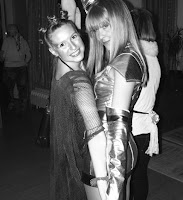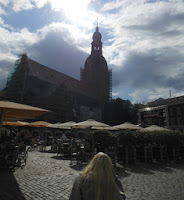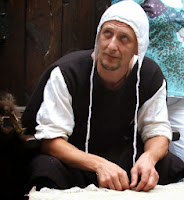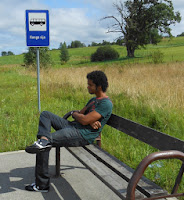It's just a smudge.
But what it becomes
In his hands:
Curving and sweeping,
Rising and reaching,
I could feel what
he was feeling.
Lines like these
have got to be
An architect's dream."
— Kate Bush, 2005
It was Halloween of 2010 when I first met Fani (pronounced like Annie), an attractive Bulgarian with an alluring nasality and eccentric taste for fifties finery. During a packed costume party hosted by friends — Karen, an English ex-pat and Eimear, attache to the Irish Embassy — I was oddly dressed in a makeshift vampire-meets-preist-meets-Neo getup, when Fani, who was comparably covered as a vampire-meets-Marilyn Monroe-meets-Princess Leia, approached just before I could attack the snack bar.
Unlike most of the partygoers who peered puzzlingly at my curious costume, Fani took the initiative to politely ask who I was. After explaining that due to a last minute decision to hunt down a costume at Sofia's All For Party store — which had virtually sold out everything righteous and recognizable — we chatted for a spell and instantly hit it off.
Keeping in mind that Sofia is a small world after all — especially when regarding ex-pats — it didn't take long before discovering we have a mutual friend in common. One you might know as well, who goes by the name of Sarah, my girl from the north country. In 2008, the former Fulbright scholars were introduced through Matt, a good friend and former Bulgarian Peace Corps volunteer. Die-hard fans of the Blog-O-Daria series might remember Matt from the second episode of the fabulous first season.
Anyhow, from that point on, Fani became not just a friend by today's frivolous Facebook standards, but a real one to rely on. You see, while Sarah was away on business, to ensure that I didn't catch a bad case of the loneleez, I hosted my first movie club (like a book club with movies instead of books) that included a ten person invitee list; a comfortable max for the living room. With the exception of my main man Joe and Fani — who arrived fashionably late — a couple of hours before start time, the other eight guests backed out for various reasons.
But don't go breaking out the violin just yet.
When Fani finally arrived to find she'd be spending her Saturday night with a couple of lonely-looking American dudes watching Jeremy leven's romantic comedy Don Juan DeMarco, instead of making me feel like the loser movie club host that I apparently must be, she pranced right on in and livened up the joint. By night's end, the three of us had a most memorable blast.
Speaking of blasting memories, during The Big Baltic Tour part 2 of a 3 part special to the Blog-O-Daria series — which included a breathtaking stroll through Europe's largest outdoor art gallery, a challenging hunt for the mighty Thor's Garden, and a random route through a mysterious burial ground located on the outskirts of a city with more brotherly love than Philadelphia, PA — Fani was once again responsible for livening up the joint. But this time she did it without showing up. Find out how . . .
"'Cause there's something
special in your sound.
Some kind of magic on your mind.
So many mysteries to find."
— Linda Lewis, 1976
SARAH'S HEAD RESTED GENTLY ON MY shoulder, as I gazed out the window of our Lux Express, a hefty travel coach liken to an airplane fully equipped with television, internet and comfortable, spacious seats. With ears cemented to the ethereal sounds of the Cocteau Twins blaring from Little Silver, a trusty iPod Shuffle about as vital to traveling as a passport, I began recounting magical moments spent in the Lovely Lithuania, while anxiously awaiting what was in store for Latvia — the next destination on The Big Baltic Tour.
By now, I can safely assume my U.S. readers are no longer scratching their heads and wondering 'where on earth is Latvia?' — or anywhere else within the great Baltic region. But just in case there's still one or two scratchers out there, sit back and relax while I sketch out another summery. . .
Officially The Republic of Latvia, it's several cornfields smaller than Lithuania and equal in size to West Virginia. However, Latvia's population is about half the size of Lithuania and less than a quarter of Bulgaria's 7 million — thus making it one of the least populous countries in the European Union.
Located 1,500 miles north of the Sunflower Capital, Latvia borders fellow Baltic states Lithuania to the south and Estonia to north, Russia to the east, Belarus to the southeast, and has an oceanic boundary to Sweden to the west — making fish a commonly consumed cuisine.
Unlike Lithuania's majority Catholic spiritual base, the largest religion in Latvia is Christianity. And like Bulgaria, only 7% of Latvia's population (which include over a quarter Russian with Belarusians, Ukrainians, Poles and a small percentage of Lithuanians and Roma rounding out the rest) attend services regularly.
Due to the neighboring influence of Lithuania, also known as the Basketball Capital of Europe, there's some big love for hoops in Latvia, making it the second most popular sport underneath ice hockey.
Like Lithuania in 1940 and 50 years after, Latvia was coercively clocked up by the Soviet Union and then Nazi Germany during World War II, thus sadly suffering mass killings of its Jewish population during the Holocaust.
In 1991, after retaining their independence and EU and NATO membership, Latvia was ranked third within the Baltic states on the Human Development Index and is currently amongst the highest income countries within the EU — a fact that was quite easy to see when perusing the middle Baltic state.
Now that you've read my summary, let me put it to my frequent U.S. travelers straight. Before planning that Summer European vacation to places like London, Paris, or Rome — you know, ultra-popular cities you may have already visited for the umpteenth time — you might want to first consider Riga, the capital and largest city of Latvia and the next stop on the journey.
"Take me to the next phase, baby.
Take me, take my soul to the next phase.
Take me to the next phase, baby.
Take me, take my soul to the next stage."
— The Isley Brothers, 1978
AFTER AN EASY PASS through the Lithuanian border into Latvia, the landscape transformed dramatically; gone were the typical Soviet-styled architecture and graffiti stained blocks, which are common to Lithuania, Bulgaria, and most of the Balkan States. Surprisingly, Latvia's landscape was pristine and the houses were nearly liken to a typical Stateside suburban home; well equipped with A-framed American-craftsman, white picket fences and spacious yards with an ample amount of green grass to mow.
First off, Riga seemed far more economically developed than Vilnius. The surrounding landscape, cobble-stoned roads, buildings and architecture (which you'll learn about shortly) was freshly renovated and reminiscent to the magical Oz-like Prague — my all time favorite European city after Amsterdam.
The second noticeable similarity were the people. Culturally related to Lithuanians, the vivacious Latvians were equally warm, friendly and mostly fair. But unlike Lithuania, they weren't too curious about my American status or coffee-colored complexion. You see, from the looks of the place, the country gets its share of yankees dropping by — and, after spotting a few Blacks and Asians here and there, a tiny percentage of people of color live there, too.
Speaking of grinning, I managed a good share after catching a glimpse of Riga's most iconic symbols. Landmarks such as St. Peter's Church (where we climbed 300 stairs to a breathtaking view), the heavily guarded, flower laden Freedom Monument, The Swedish Gate, Riga Radio Tower (the tallest structure within the EU), the sadly scaffolded Riga Cathedral, The Cat House (that once begrudged the Large Guild), Rozena Iela (the narrowest street in Latvia) and the ever-popular Three Brothers' Buildings (Riga's oldest complex of dwelling structures) were all a treat for the eye and camera to behold.
While on the subject of brothers, I can't forget to mention that Riga is home to the most brotherly love I've ever witnessed in Europe. I know what you're thinking. And no, not like in Philly, where the name Philadelphia is derived from the Greek meaning The City Of Brotherly Love. I'm not even talking about the love for a male sibling. What I'm referring to is that iconic 70s slang for Black man — meaning 'brother' or some might prefer to say, 'brotha.'
You see, after learning that Riga's most iconic city symbol is a magnificent structure with a Black man emblazoned on it, I have to admit that this stark image in a predominately white city raised a notion: if there's a city more deserving of the name The City Of Brotherly Love, it should be Riga.
Situated in the old town, the House of the Blackheads was erected during the 14th century for the Brotherhood of the Blackheads, a social organization for unmarried German merchants in Riga. The structure was unfortunately bombed to a ruin by the Germans in 1941 and its remains were demolished by the Soviets in 1948. However, in 1999, the building was reconstructed into one of the most splendid views the city has to offer. Power to the people — right on!
"Now and then,
Firelight will catch us
stumblin' in."
— Chapman and Chinn, 1979
ONE OF THE GREATEST PERKS OF traveling is stumbling onto something cool. Or in this case, something cool and creepy. You see, it had been quite some time since I had a good cemetery hunt. So, the next morning after a quick pitstop at a yummy cafe near Dome Pearl, I got my wish.
Call it a stumbling kind of day. But after Sarah stumbled onto Liama Saldumu Veikals, a yummy chocolate joint, a few minutes later, we stumbled onto a massive burial ground established in 1773 and, formally, the main cemetery of Riga for upper class Latvians, such as famed actress Vija Artmane.
But that's not the best part of it.
Upon closer observation, eagle-eyed Sarah, my great historian from the north country, spotted a post-war, denazified German cross emblazoned on a crypt, which led her to look into the history of the cemetery. So, with a little help from Mr. Google, she discovered that the cemetery was also the resting place for Baltic Germans who died between 1773 and 1944.
Extensive damage and removal of many of the headstones and graves by the Soviets governing the Latvian SSR after 1945 led to the suspension of burials and the eventual conversion of the burial ground into a public park, which seemed bizarre to us. Despite this, though currently graffiti garbled and quite neglected, a significant amount of graves remain intact to this day.
"Through time and space,
Thor's hammer flies."
— Mike Brancaccio, 1969
FOR EVERY EASY CASTLE HUNT, THERE'S A tougher one ahead. You see, after easily stumbling onto that mysterious burial ground, and in Lithuania there was that easy automatic hunt to Trakai Castle, and Riga Castle was also an easy find that wasn't exactly impressive — as city castles tend to get lost in the sauce — the brave and fearless one with his trusty blonde companion were yearning for a big challenge and they got one.
So, on the following day we clutched our compasses and set out for Turaida Castle which means Thor's Garden, located in Turaida on the opposite bank of the Gauja River. And after a couple hours of heavy hunting which included a short train to a sightly small town called Sigulda, where we took a high wired cable car through a dense forest, then hiked along a seemingly endless six-mile country road — all the while receiving help from friendly Latvians — we finally located Thor's Garden.
And like so many great castles that gave us a challenging hunt, upon arrival, Thor's Garden ended up being well worth it. Built in 1214 by Albert of Riga, the interior and grounds were simply gorgeous and fit for a thunder god. It also included a museum, sculpture garden, waxed figures, a few torture chambers, and a breathtaking view from the tower.
"He's for the money,
he's for the show.
Lido's a waitin' for the go."
— David Paich and Bozz Skaggs, 1976
IF YOU'RE A DEDICATED BLOG-O-DARIA reader, you'll know that it maintains a magnificent motto that says "the people of a country are the most important aspect of truly enjoying a country." Well, there's another part that connects to this statement and it goes something like this: "hanging out with a friend well acquainted with a country is like having a cherry on top of a double-decker chocolate mud cake."
Why?
That's simple. A native or someone vastly familiar with a country will most likely show you places off the touristy beaten path. Like on the final day of the Vivacious Latvian leg of the Big Baltic Tour when Sarah and I met up with a Latvian native and close friend of Fani's named Agris.
Weeks before The Big Baltic Tour, after Fani got wind of our plans to stop through Latvia, she was persistent in hooking us up with her guy. And though my girl from the north country was keen on connecting, I was unruly resistant. You see, and this may come as a surprise to most, I'm not always up for meeting strangers on vacation for 3 vital reasons.
1.) I don't know them.
2.) If things don't work out, it could potentially ruin my whole vacation.
3.) I don't know them!
Now that you know this, you'll have a better idea why convincing me to meet up with Agris was like pulling teeth from a saber-toothed tiger. And though Fani is one of the sweetest and most outgoing people I know in Bulgaria — who would more than likely attract people of the same kind — for some odd reason, I was bent on believing Agris was going to be about as boring as watching a televised baseball game on Sunday.
Boy, was I wrong.
Agris was about as cool as they come. The three of us got along like old chums meeting up for a class reunion. And to add proof to Blog-O-Daria's magnificent motto, because Agris is a native to Latvia, he introduced us to something we would have surely missed; a yummy themed restaurant called Lido, not to be confused with Maryland's own Ledo, America's best pizza according to The Big O's — me and Oprah.
While Lido's pizza was of no comparison to Ledo (no pizza in the world is for that matter), its animated ambience and mixed cuisine was of equal enjoyment. Known for its home brewed beer, Lido's unique log-house styled interior featured a bevy of buffets, live deejay and dance floor, and an old school windmill laden exterior and grounds liken to a miniature amusement park loaded with fun rides, go-carts, and baby bungee jumping.
And even though we didn't partake in the latter activities, getting acquainted with Agris and learning some firsthand knowledge of his vivacious country was just a thrilling.
Thanks again, Fani.
"I've got some memories
to look back on.
And though they help
me when you phone,
I'm well aware nothing
can take the place of being there."
— Ashford and Simpson, 1968
NO ONE CAN DENY THAT PHOTOGRAPHS AND video are the best ways to preserve treasured travel memories. However, when I glance through pictures from past dream destinations like the Great Pyramid, Eiffel Tower, Parthenon, Grand Canyon, or Neuschwanstein, these age-old methods never quite measure up to how they appeared in person. So, while I showcase several images from one of the top moments on The Big Baltic Tour — which may be pleasing to the eye — keep in mind that there's truly nothing like the real thing.
Located on Albert Street, Riga's historic art nouveau section is consummately characterized and recognized by UNESCO's World Heritage Site as "the finest collection of art nouveau architecture in Europe," mainly for its "quality and quantity." After Riga experienced an unprecedented financial and population boom between 1857 to 1915, the architectural bourgeoisie used their wealth to erect over 800 eye-catching art nouveau buildings in the heart of city's center and old town.
On the final day of the Latvian leg of The Big Baltic Tour, after a late lunch at the yummy Lidojosa Varde (The Flying Frog) — another highly recommended dining destination when perusing Riga — in the early evening hours Sarah and I took a slow scenic stroll through what I call the world's largest outdoor art gallery of the most splendid architecture I'd ever laid my baby brown eyes on.
For the folks who may have gotten inspiration from this episode of the Blog-O-Daria series and plan on checking out the Vivacious Latvia and Riga's amazing art nouveau during your next European vacation, please allow me to leave you with some cautionary advice: bring along the comfiest neck brace you can possibly find.
Though well worth it, after having my head reclined for the duration of the three-hour stroll, the next morning I suffered a stiff neck.
O








































































































































Hi Owen! I truly enjoyed reading this, so entertaining. The pictures are amazing.
ReplyDeleteThanks so much for sharing.
Much love,
Joy
You're welcome, sis! Thanks for reading! Hope to see you, Mark, and the kids this Christmas!
DeleteLove,
O